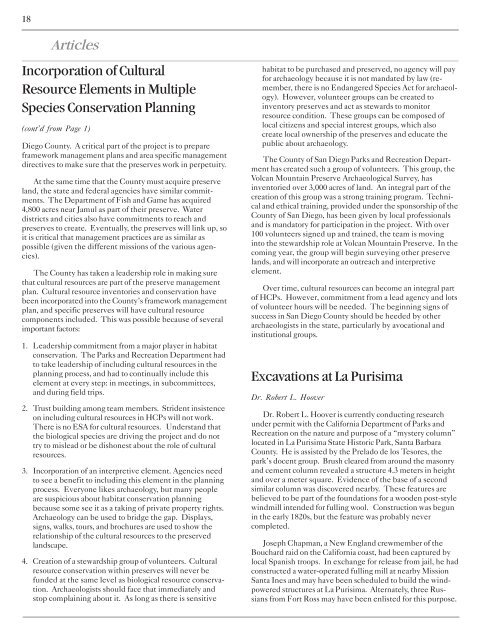March 1999 - Society for California Archaeology
March 1999 - Society for California Archaeology
March 1999 - Society for California Archaeology
You also want an ePaper? Increase the reach of your titles
YUMPU automatically turns print PDFs into web optimized ePapers that Google loves.
○ ○ ○ ○ ○ ○ ○ ○ ○ ○ ○ ○ ○ ○ ○ ○ ○ ○ ○ ○ ○ ○ ○ ○ ○ ○ ○ ○ ○ ○ ○ ○<br />
18<br />
Articles<br />
Incorporation of Cultural<br />
Resource Elements in Multiple<br />
Species Conservation Planning<br />
(cont’d from Page 1)<br />
Diego County. A critical part of the project is to prepare<br />
framework management plans and area specific management<br />
directives to make sure that the preserves work in perpetuity.<br />
At the same time that the County must acquire preserve<br />
land, the state and federal agencies have similar commitments.<br />
The Department of ish and Game has acquired<br />
4,800 acres near Jamul as part of their preserve. Water<br />
districts and cities also have commitments to reach and<br />
preserves to create. Eventually, the preserves will link up, so<br />
it is critical that management practices are as similar as<br />
possible (given the different missions of the various agencies).<br />
The County has taken a leadership role in making sure<br />
that cultural resources are part of the preserve management<br />
plan. Cultural resource inventories and conservation have<br />
been incorporated into the County’s framework management<br />
plan, and specific preserves will have cultural resource<br />
components included. This was possible because of several<br />
important factors:<br />
1. Leadership commitment from a major player in habitat<br />
conservation. The Parks and Recreation Department had<br />
to take leadership of including cultural resources in the<br />
planning process, and had to continually include this<br />
element at every step: in meetings, in subcommittees,<br />
and during field trips.<br />
2. Trust building among team members. Strident insistence<br />
on including cultural resources in HCPs will not work.<br />
There is no ESA <strong>for</strong> cultural resources. Understand that<br />
the biological species are driving the project and do not<br />
try to mislead or be dishonest about the role of cultural<br />
resources.<br />
3. Incorporation of an interpretive element. Agencies need<br />
to see a benefit to including this element in the planning<br />
process. Everyone likes archaeology, but many people<br />
are suspicious about habitat conservation planning<br />
because some see it as a taking of private property rights.<br />
<strong>Archaeology</strong> can be used to bridge the gap. Displays,<br />
signs, walks, tours, and brochures are used to show the<br />
relationship of the cultural resources to the preserved<br />
landscape.<br />
4. Creation of a stewardship group of volunteers. Cultural<br />
resource conservation within preserves will never be<br />
funded at the same level as biological resource conservation.<br />
Archaeologists should face that immediately and<br />
stop complaining about it. As long as there is sensitive<br />
habitat to be purchased and preserved, no agency will pay<br />
<strong>for</strong> archaeology because it is not mandated by law (remember,<br />
there is no Endangered Species Act <strong>for</strong> archaeology).<br />
However, volunteer groups can be created to<br />
inventory preserves and act as stewards to monitor<br />
resource condition. These groups can be composed of<br />
local citizens and special interest groups, which also<br />
create local ownership of the preserves and educate the<br />
public about archaeology.<br />
The County of San Diego Parks and Recreation Department<br />
has created such a group of volunteers. This group, the<br />
Volcan Mountain Preserve Archaeological Survey, has<br />
inventoried over 3,000 acres of land. An integral part of the<br />
creation of this group was a strong training program. Technical<br />
and ethical training, provided under the sponsorship of the<br />
County of San Diego, has been given by local professionals<br />
and is mandatory <strong>for</strong> participation in the project. With over<br />
100 volunteers signed up and trained, the team is moving<br />
into the stewardship role at Volcan Mountain Preserve. In the<br />
coming year, the group will begin surveying other preserve<br />
lands, and will incorporate an outreach and interpretive<br />
element.<br />
Over time, cultural resources can become an integral part<br />
of HCPs. However, commitment from a lead agency and lots<br />
of volunteer hours will be needed. The beginning signs of<br />
success in San Diego County should be heeded by other<br />
archaeologists in the state, particularly by avocational and<br />
institutional groups.<br />
Excavations at La Purisima<br />
Dr. Robert L. Hoover<br />
Dr. Robert L. Hoover is currently conducting research<br />
under permit with the Cali<strong>for</strong>nia Department of Parks and<br />
Recreation on the nature and purpose of a “mystery column”<br />
located in La Purisima State Historic Park, Santa Barbara<br />
County. He is assisted by the Prelado de los Tesores, the<br />
park’s docent group. Brush cleared from around the masonry<br />
and cement column revealed a structure 4.3 meters in height<br />
and over a meter square. Evidence of the base of a second<br />
similar column was discovered nearby. These features are<br />
believed to be part of the foundations <strong>for</strong> a wooden post-style<br />
windmill intended <strong>for</strong> fulling wool. Construction was begun<br />
in the early 1820s, but the feature was probably never<br />
completed.<br />
Joseph Chapman, a New England crewmember of the<br />
Bouchard raid on the Cali<strong>for</strong>nia coast, had been captured by<br />
local Spanish troops. In exchange <strong>for</strong> release from jail, he had<br />
constructed a water-operated fulling mill at nearby Mission<br />
Santa Ines and may have been scheduled to build the windpowered<br />
structures at La Purisima. Alternately, three Russians<br />
from ort Ross may have been enlisted <strong>for</strong> this purpose.
















